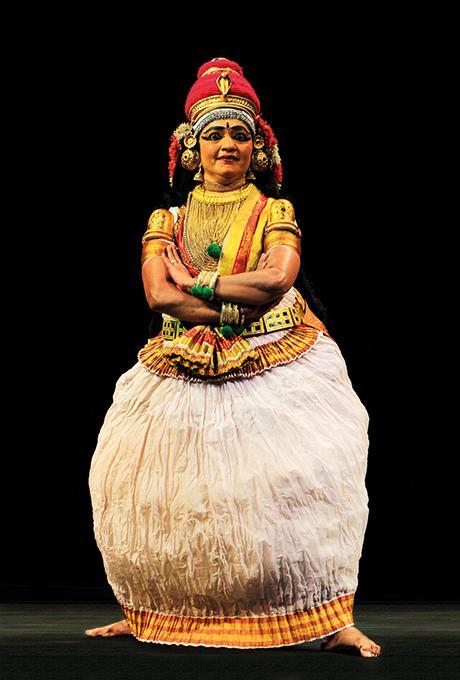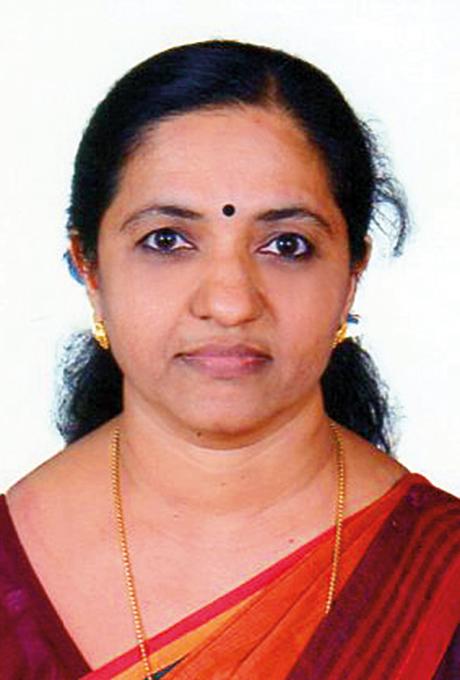'Koodiyaattam is a vehicle for my inner voice'
Ahead of her performance in Dubai, Usha Nangiar, one of the foremost exponents of koodiyaattam, tells Anand Raj OK why this ancient art form from Kerala is still relevant today
Usha Nangiar’s voice is soft and mellifluous, often lapsing into a soothing lyrical tone, particularly when she describes koodiyaattam, the ancient Kerala temple theatre art form that she holds close to her heart, and of which she is an award-winning exponent.
A teacher in the koodiyaattam division of Kalady Sankaracharya University in Kerala, she has been practising the art since she was 10, thanks to her father Chathukudam Krishnan Nambiar. A well-known mizhavu (the pot-shaped percussion instrument used in the performances) artiste, he offered his daughter unstinting support, encouraging her and honing her skills. Training under Dr Madhava Chakyar at Ammannur Gurukulam, Usha admits the early years of practise were difficult, but she managed to overcome it all ‘because of my love for koodiyaattam’.
[Kerala: Beyond the backwaters]
So passionate is the 50-year-old about the art form, that she finds it difficult to separate it from her life. ‘My life and koodiyaattam are one and the same thing,’ says the Kerala Sangeetha Nataka academy award-winning artiste, in an exclusive interview with Friday ahead of her performance in Dubai. ‘I don’t consider this my profession. It’s my life. Koodiyaattam is who I am.’
Recognised by Unesco as a ‘Masterpiece of the oral and intangible heritage of humanity’, koodiyaattam, which literally translated means combined acting, was until recently restricted to inner temple performances. A more than 2,000-year-old Sanskrit theatre form, it emerged from the temple stages onto public platforms only in the mid-1960s and is now staged in venues across India, the UAE and even the West.
The only surviving art form to use drama from ancient Sanskrit theatre, it is slowly experiencing a resurgence in popularity, particularly in the UAE where a koodiyaattam performance by Usha is going to be a headline event at Utsavam-IKKF. Organised by Traditions Live, a group of art lovers in the UAE, the cultural extravaganza showcasing Kerala’s legendary art forms will be staged from November 29 until December 2 at Gems Wellington International School in Dubai. The event is free and open to all.
Offering an insight into koodiyaattam, Usha, a graduate in statistics, says the art form is bound by strict laws and rules vis-à-vis its performance. ‘It is pure theatre. The character’s thoughts are what the actor brings to the fore in each performance,’ she says. ‘There is less reliance on body movements and more on emotions displayed on the face.’

Traditionally, a full-length koodiyaatam recital used to be performed over 32 days with a three-hour session every day. However, modern recitals are restricted to around three hours.
Most of the stories enacted are taken from the Indian epic Ramayana. Rarely, stories from the Mahabharata too are enacted, she says.
Usha has often been termed as an artiste who has pushed the boundaries of koodiyaattam by bringing to life several female Indian mythological characters such as Mandodari, Ahalya, Draupadi, Tara and Sita – together known as panchakanyas – who hitherto had never been enacted on stage.
‘That is not completely true,’ says the thespian. ‘All the characters I’ve been performing were all once upon a time part of this art form. I’ve researched extensively into koodiyaattam, reading and rereading palm-leaf manuscripts that date back several centuries, and have discovered that once upon a time the panchakanyas were enacted in koodiyaattam – but only within the temples. However, for reasons not known, over the years these characters were excluded completely from this art form. I’ve only brought them back to the stage.’
Although modern in her thinking and keen to give koodiyaattam its due and take it to centrestage, Usha is unwilling to tamper with the basic tenets of the form. ‘The basic rules are sacrosanct and should not be tampered with,’ she says. ‘New creations can be included into this form but they should be done without losing or interfering with the essence of this form.’
Usha also feels that bringing about changes in the art form just for the sake of it may not be wise. She makes it clear that ‘there are several characters already in this repertoire. We only need to find them and bring them to the stage.
‘It’s easy to enact a character that has not been done before because there are no reference points to judge it against. The difficulty lies in presenting existing tales with precision and without deviating from the tenets laid down in the ancient texts,’ she says.
Has the portrayal of characters changed over the years?
‘If in ancient times form was the most important element in a performance, today, I feel it’s important to concentrate on the character. So our thoughts, our culture, our life and our experiences will all be reflected in this character’s enactment. We can then give the character a new perspective; a new interpretation.’
What is the relevance of this art form to the youth of today? I ask.
‘Koodiyaattam is a performance that has a very slow tempo. It goes against the grain of today’s lifestyle, which is so fast paced. A lesson youth can learn from koodiyaattam is how by reducing the pace of our modern lifestyle, pausing to smell the flowers, so to speak, you can get to enjoy a more intense, more detailed and clearer picture of life. It will be more enjoyable and you will get a better perspective of everything. You get to appreciate and enjoy things at a deeper level – much more holistically.’
Art forms like koodiyaattam, she insists, can help bring about a change internally – ‘it can help you introspect, view an issue from a different, completely novel perspective and learn to recognise that every issue can have more than one point of view.
‘I want to encourage the youth to look within themselves, to find out their true self, to encourage them to resonate with the character I am presenting on stage.
Has enacting all these strong-willed, powerful women characters on stage changed her personality in any way?
Usha is quick to reply. ‘Oh yes,’ she says. ‘It surely has. I’ve always believed that the stories from the ancient epics offer us a lot of lessons on how to face challenges in one’s life with courage and pride. This is particularly true of the stories of some of the legendary female characters. The Panchakanya have had to struggle a great deal to get ahead in their lives. They’ve had to fight for their community, their families, their selves... They’ve suffered but survived. They refused to become slaves, instead fighting with their head held high to overcome challenges.

‘Those values have seeped into my life as well. In a sense, they have become part of me and I of them.’
How does she view koodiyaattam?
‘To me, the art form is only a medium to carry my message. There are several messages that I am unable to shout out to the world openly. So I use this form as a vehicle of my thoughts, my dreams, my aspirations… It is a vehicle for my inner voice.’
What gives her the greatest joy? ‘The relaxation that comes after a great performance,’ says the artiste. ‘Nothing can beat that. There is no anger, ill feeling or negative emotions within you. It is truly a state of bliss. I can’t imagine a life without koodiyaattam. I can give up just about everything but not this because, as I said earlier, this is life. This is me.’
Apart from Usha Nangiar’s koodiyaattam performance on November 29 and December 1 at the Gems Wellington International School in Dubai, there will also be all-day-long kathakali and other Kerala art form presentations until December 2. More details at traditionslive.org.